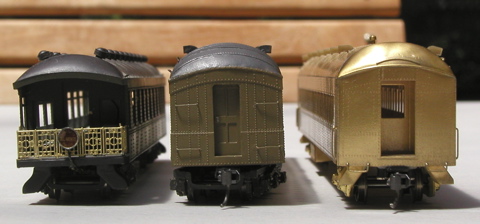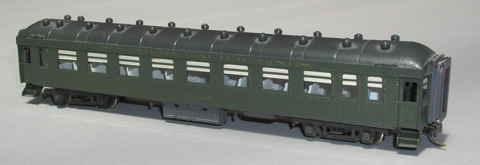
Comparison of rooflines of Harrimans: Ken Kidder, SC&F resin kit, Soho brass
I'll detail how I improve MDC and Ken Kidder passenger cars.
Making a passable 60-B-1 baggage car from an MDC Harriman baggage car kit
Photos from the 1930's show that the Santa Cruz train normally had an RPO car, but baggage cars could still be useful on my layout. I've built one baggage car from the MDC Harrimans.
Model Die Casting has made plastic Harriman passenger cars for years. These cars are easily available, but only the baggage car is the correct length. The coaches are about 7 feet too short. Windows on the coaches are also too low, and make the car look wrong.
I detailed one MDC Harriman body to make it look more appropriate. First, the trucks that come with the kit are too small. The trucks need to be moved out so they're 52' apart -- about 3' out on each end. They also need to be replaced with the 8' wheelbase trucks. The underframe's also too plain. I ended up fabricating a new underframe from sheet plastic, detailed it, and body mounted the couplers. The roof is pretty good as-is -- I did switch the air vents from the round ones to the squarish utility vents (Precision Scale part 33186), and filled the holes for the old vents.
There's also a picture of 60-B-9 (or so) on page 106 and 146 of "Night Trains of the coast" which shows a bit of underframe detail. In this photo, no battery box is visible. At least one at least one air tank's visible under the car.
Detailing Ken Kidder brass Harriman cars
I need several coaches for the Santa Cruz trains. I use 60-C Harrimans for the trains over the hill. Even if these aren't prototypical (the 1939 photos seem to show commute coaches used on this train), they're short enough to handle the sharp curves of my layout. Rather than buy a bunch of $300 Precision Scale cars, I use Ken Kidder Harriman cars. These are affordable (around $40 each), and are also much more fun because I can paint and detail these cars myself. The Ken Kidder cars are from the early days of brass; they have a too-shallow roof curve (which isn't noticeable when these cars are in a train by themselves), missing roof conduit and the wrong air vents, no interior detail, a wood floor, and no floor detail.

Detailed Ken Kidder Harriman coach
To improve the cars and give myself some fun scratchbuilding, I get rid of the wood floors and fabricate my own underframes for these cars out of styrene. The floor is 0.020 inch sheet styrene. so that they fit between the floor support brackets on the Ken Kidder cars. I add enough detail to make these cars interesting. I usually add a battery box, brake cylinder, and brake valve, generator, brake rods and piping, one or two air tanks, and vapor regulators. The vapor regulators are part of PSC's underframe kit, and were used (I assume) for venting steam lines. These are short pipes that stick down from the floor. Regardless of whether they're prototypical, they help make the underframe look busy.

Ken Kidder Harriman underframe after detailing
I've been really happy with these floors; I enjoyed researching how the floors were built and how the brake systems were laid out, and I'm glad they've got somewhat prototypical floors.